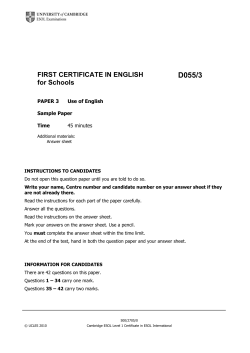
HAckathon Teams print - Nordic IoT Hackathon | 2015
www.nordiciothackathon.com © Linda Malmgren TEAMS MVD SPONSORED SMART TRANSPORTATION HackLab - Spain PSALM - Russia We could develop some improvements into MVD firmware like get it yo have its own web server, a UI or secure communications between the sensors of the network and the MVD device to ensure that there is no polluted data. Security is an important feature to be considered in the MVD device in public places, like stations, platforms and bus stops. We dedicate our project to data collection automation to increase satisfaction from using public transportation and to ensure safety driving and constant road pavement quality monitoring. We are going to achieve this by presenting a unified platform for public transportation monitoring, powered by real-time sensors data and passengers’ feedback. Another hack that we could do is to develop an Android app which allows to have the same services described above (web server, UI, secure communications) without modify the firmware of the MVD device. We may also provide to the MVD device a high-level API that allows to interact with sensors and actuators network in a simple way as it does Protocoder. Evgeny Levenets Andrey Prokopiev Alexey Schebelev. Vladimir Aluferov Andrey Melentyev Víctor Suárez José A. Álvarez Miguel A. López David Rodríguez Víctor Díaz José. J Sánchez Ismael Olea Seamless Travel Experience - Sweden Skånetrafiken 2.0 - Sweden Smarter ticketing: We will make it easier for the customers to pay for their travels by enabling recharging, in real time, and storing of virtual cards in their mobile phones. Our solution will handle automatic payment and zone handling via GPS and BLE. The customers will only need to scan their phone (the MVD will register the phone) when they enter the bus. The connection will automatically end when the customer leaves the bus. Our application provides information about the current traffic situation to both everyday users as well as to Skånetrafiken. The MVD at each bus stop detects users in the vicinity of bus station, and the application provides them with the instant option of choosing a departure from the bus station. Smarter planning: We also want the traveler to be able to see nearby bus stops and exactly where a specific bus is located, in real time. This makes it easier for the traveler to plan the day since he can see ahead of time if he will get to the bus stop in time. It is also usable if he is unfamiliar with the area since he can see the bus stops around him. Smarter collaboration: Finally we want third party services to interact with Skånetrafiken. During the bus trip the traveler will be able to see journey offers in the app. These offers will also be based on the traveler’s trip, for example transit stops and waiting time between busses. Joakim Jönsson Simon Lagos Victoria Nordin Robert Bärlin Andreas Lundsten Erdal Bejtula Via the internet, the MVD provides Skånetrafiken with information about how many users are at a particular station and where they are headed. Over a long term this allows for better traffic planning, while in the short term, in cases of heavy traffic it allows for seeing where extra buses should be allocated in order to prevent delays or full buses. At the same time, we provide an incentive for usage to end users by providing easy access to current departures from a station, and once on board the bus, the application can provide information about delays and alternative routes in cases of missed connection. Marcus Lacerda Olle Tervalampi-Olsson Jacob Arvidsson Rikard Lundberg Vilhelm Sjölund Martin Larsson SMART HOMES PowerPlateau- Germany, Canada, USA Power Plateau aims to reduce our society’s peak power consumption by balancing individual loads from appliances within a person’s home. It will coordinate the on- and off-times of appliances, resulting in stable and efficient energy usage. The idea is that every outlet is connected to a central control system, that can also be controlled from a user’s computer or phone. A user can set appliances to cycle ‘automatically’ (ideal for a refrigerator, or any always-on device), or he or she can program an appliance to run on a schedule or finish by a certain time (ex. dishwasher). This is the usage request. The system would consider these user defined constraints as well as all other usage requests throughout the grid when computing the most balanced schedule for all usage requests. The appliance interface would then receive and implement this approved schedule. Julia Chernushevich Brent Komer Afsheen Ghorashy Sara Greenberg Elmira Reisi Bold Travel - Sweden Busspelet Färgglatt - Sweden During the hack we would like to adress two issues connected to the travel experience: On- and Off-boarding and accessing realtime travel data on the go using wearables. The On- and Off-boarding By adding MVD’s with connected light sensors and lights above seats on trains we create an infrastructure of seating guidance and information (SGI) that will ensure an easier and more effective travel experience. By adding smart behavior predictions and guidance to the system we can direct people and flows to different parts of trains and carts to spread out during On- and Off-boarding to match connecting trains, personal preferences or needs like quiet- , allergic- or handicap-accessible using the travelers own devices like mobile phones, tablets or wearables. Travel data ”on the go” with wearables By giving user centric geographically bound information to travelers on the go we also create value in analyzing and directing traffic and give critical information back to travel companies. The wearable interface can include ETA to train arrival and to end-destination, give vibration alerts on delays and when your stop is coming up, it will also be able to add new services and innovation in time, that can be context and personally customizable. Our team is going to hack on a simple multiplayer game centered around two teams coloring a map. The game is to be hosted on the Minimum Viable Device which is at the core of the hackathon, and will have players connect to the game with their smart devices. Each round is short, as the aim of the game is to be played by buss passengers together against their fellow travelers. Furthermore, the purpose of it all is to attempt to create a more amiable atmosphere for passengers. Ingemar Pettersson Sebastian Simson Alexander Simson Jonathan Nery Alexander Cobleigh Axel Mårtensson Axel Smeets Tweet the Heat - Finland FESG: the Family Energy Saving Game - Italy We want to monitor the surface temperatures of all radiators in an apartment building. In addition, the temperature of each room in every apartment should be monitored. By gathering enough data we could establish a unique “heating profile” for each monitored apartment in the building. Any deviations from this profile could be detected with analytics and these anomalies could be communicated to the interested users. Our vision is that the monitoring system is cost effective and easily retrofitted to older apartment buildings. The key part is involving the people living in the building and making them aware of heating related topics. In addition to notifying the users of the building our concept would create a view of the entire building’s state that could be utilized by maintenance personnel. Building systems are typically disconnected from each other. Tweet the Heat will not be. Our vision is to allow other systems to subscribe to heating related events and help them make informed decisions. The project is designed as follows: the sensors and actuators (like light, temperature and presence sensors, relays and smart plugs) are connected to the MVD via BLE, where their status is monitored and changed. The data from the domestic power infrastructure is relayed back through the the ELIS cloud server to a mobile application where, according to certain algorithms and simulations, a target level of energy must be saved. This activity may be performed either remotely (on the smartphone) or locally by the children, who earn points. At the end of a given period, the parents may decide to reward them with treats, or special permissions as trust prizes. A further aspect of this application, is that it may strengthen the bonds between members of the family, who join together as an energy saving team. Local utilities may also be interested in co-branding the game and integrating it in the broader range of their social campaigns. Jussi Kirkkopelto Juha Kaarlas Larisa Deac Toni Aittomaa Markus Suominen Mikael Guek Stefano Di Segni Giuseppe Siracusano Francesco Lombardo Alireza Ramezani BiSmart - Sweden Smart home profiles - Romania Our goal is to make a IoT system that is simple to get started with, and highly integrated with home appliances, both those that can have own APIs (over wifi, bt etc) but also with clean embedded devices like the MVD of this project that can collect and control I/O. It will enable all the homes to connect things like, doors, pumps, temperature, power consumptions, power control, flood sensors, alarms, ovens, lights, food ordering, music stations, greenhouse watering as well as garden mowing, in-house vacuuming, the list can be long, but the essence for us is to make a real world working product that shows off the simplicity of our system but also that invites anyone in the end to purchase and use our devices to control those things. Our idea is to bridge hacked home appliances (heaters, AC, fans, etc) to a profile-enabled cloud app that regulates one's home environment. We'd like to put a MVD in each room and hack a BLE + actuator + temp sensor in each appliance, be it an old heater (mechanical hack) or a thermostat (digital hack), send all data to a central location via home's internet connection (to elis or whathaveyou). On the data lake formed in the cloud, we would define (preferably ML) profiles - and interact with the user via the mobile app. The system would send back data to actuators to ensure the profile is applied. For the hackathon, we want to make the available parts fit together and see how far can we go. Sebastian Jonasson Felix Ruponen Victor Axelsson Jörgen Buder Andrei Calbajos Kim Velker Adrian Barbos Daniel Radu
© Copyright 2025








